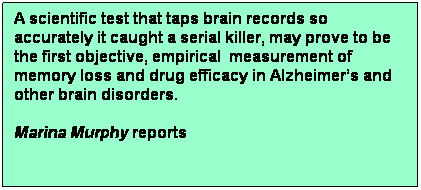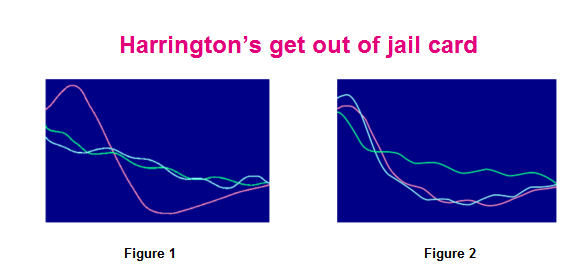

News Feature
Infallible
witness
CIA double agent Aldrich Ames managed to
pass polygraph tests, designed to find traitors,
even as he was selling out other US agents to
the Soviet Union. Polygraphs — conventional lie
detector tests — are based on emotional
responses to stress such as increased heartbeat
and blood pressure, and excessive sweating.
Responses that can be faked.
But whatever the outward response, the brain
will always answer honestly. Discovering this
answer from involuntary brain activity is where
brain fingerprinting (BF) comes in. BF taps into
the specific information stored in a person’s
memory, providing a scientific solution to the
problem of identifying criminals and trained
terrorists. This scientific determination of
guilt or innocence has been ruled admissible in
US court, meaning this new branch of forensic
science has the potential to revolutionize the
whole justice system. Indeed, the revolution has
already started.
In February 2004, a Brain Fingerprinting test
showed that Jimmy Ray Slaughter's brain did not
contain a record of salient features of the
crime of which he had been convicted.. He is on
death row in Oklahoma for the murder of his
girlfriend Melody Wuertz and their daughter
Jessica. Slaughter’s fate is not yet known. But,
the implications of the technology will reach
much further than the criminal world. BF
creators Brain Fingerprinting Laboratories,
based in Seattle, say the same technology will
be used to speed to market drugs for brain
disorders including Alzheimer’s disease (AD) and
Hutchinson’s, help identify fraud, and
strengthen security in areas such as visa
applications and protection of classified
information.

Farwell measures brain-wave responses of
a person looking at words or pictures displayed
on a computer screen using a headband with
built-in electrodes
The Gazette/Buzz Orr
Brain waves
The most detailed knowledge of any
crime is locked away in the brain of the person
who committed it. BF provides a method by which
these invisible clues can be tapped to
determine, with scientific certainty, whether
the story a suspect is telling matches what is
stored in his or her brain.
BF test results suggest that Slaughter’s story
and the information in his brain match. His
claim to have no knowledge of the murder scene
was proven to be true, enough to question the
validity of the guilty verdict and have him
granted a stay of execution. The same technology
could soon be available to establish the guilt
or innocence of suspects at a much earlier
stage.
‘I envision that over the next 10–20 years
police officers and investigators throughout the
world will be trained as part of their regular
law-enforcement education to record the elements
of a crime scene for use in BF tests,’ says Drew
Richardson, a former US Federal Bureau of
Investigation (FBI) agent and scientist, who
joined Brain Fingerprinting Laboratories. ‘Up to
70% of major crimes would be appropriate someday
for BF technology,’ he says. Conventional
fingerprinting and DNA is only available in 1%
of cases. Brain Fingerprinting Laboratories hold
three patents for BF testing in the forensic
area.
‘Ah-ha’
The technique is not for interrogation.
It does not require any questions or any
answers. It reveals objectively whether
information is present in the brain, regardless
of whether any false or truthful statements are
made by the subject. The brain does the talking.
Hidden information is uncovered by measuring
brain-wave activity in response to crime-related
pictures or words. Changes in brain waves allow
a determination of ‘information present’ or
‘information absent’ regarding specific details
of a crime in a specific brain. ‘We cannot
download the contents of the brain,’ says BF
inventor Laurence Farwell of Brain
Fingerprinting Laboratories. ‘But what we can do
is determine whether the suspect recognizes
details significant in the context of a crime.’
Presented with details of the crime, the guilty
person cannot help but elicit an involuntary, but
detectable spark of recognition in the brain. This
response is automatic, so there is no way to
suppress or fool the system. ‘If an elephant were
to walk into the room, you may not respond
overtly, but your brain cannot help but recognize
that it is an elephant. There is always the
“ah-ha” response in the brain,’ says Farwell.
Find the MERMER and you have found
the murderer
The ‘ah-ha’ response is characterized by
specific, measurable brain response known as a
MERMER. A MERMER will only be emitted by the
brain of the perpetrator, with details of the
crime in his brain, and not by an innocent
suspect who does not have this record in his
brain. Find the MERMER and you have found the
murderer.
MERMER
A MERMER is a part of the brainwave
observed in response to familiar information.
When the brain recognizes something, the memory
centres are stimulated. The neurons fire
synchronously, eliciting characteristic changes
in brain activity. It is these changes, which
can be measured using electrodes, that
investigators look for when trying to determine
whether someone recognizes a particular piece of
information.
When subjected to a rare, but meaningful
stimulus, increased neuron activity results in
an increase in voltage, typically within
300–1000msec after the stimulus, called a P300.
This is called an event-related potential (see
Box, above). For example, if a subject is
exposed to a series of random names and
occasionally one of those names is the subject’s
name, a P300 response is evoked.1,2
The utility of the P300 in detection of
deception was recognized as early as 1988, when
it was shown that it could be used to identify
college students concealing guilty knowledge of
having stolen something.3
However, the P300 has only a 87.5%
success rate in revealing the presence of
relevant information.
Farwell’s test is based on the discovery that
the P300 is only a subcomponent of a more
complicated response called a MERMER, which is
elicited when a person recognizes and processes
a stimulus that is particularly noteworthy to
him/her.4
The MERMER, memory and encoding related
multifaceted electroencephalographic response,
includes the P300 and another longer latency,
electrically negative subcomponent with a
latency of up to two seconds post-stimulus. In
other words, a positive wave followed by a
negative one. Tests using the MERMER produced no
false negatives or positives and no
indeterminates.4
When details of a crime are known to
the suspect, a MERMER will be detected. A MERMER
will not occur in an innocent subject.
However, there is one major drawback. Although
it is possible to determine whether information
is present in the brain, it is not possible to
say why it is there. This is why investigators
have to find information that only the guilty
person will have. This means eliminating any
details that may have come out during the trial,
for example, to which an innocent person may
have been inadvertently exposed.
Event-related
potentials
There
are about a billion neurons in the brain that
communicate with each other using electrochemical
signals. The ongoing changes in these signals,
which are measured using scalp electrodes, are
recorded as continuous changes in voltage over
time, called the electroencephalogram (EEG).
Buried in the EEG are signals that reveal
information about brain processes. These signals
are detected by timing changes in the EEG with the
onset of events such as listening to a sound or
viewing a picture. The resulting activity is
called an event related potential (ERP), which is
distinguishable from background brain activity.
The ERP can be broken down into several basic
components represented as positive or negative
fluctuations in the ERP waveform. Components that
occur prior to 100ms are thought to reflect
information processing in the early sensory
pathway, for example the auditory neural ERP stems
from neuronal impulse traveling from the cochlea
through the auditory brain centres. Longer latency
ERP components include P1, P2, N1, N2, N400 and
P300 components. These are named by the polarity
(P for positive) and either their ordinal position
(P1 is the first positive wave) or their latency
after onset of stimulus (N400 is a negative
fluctuation peaking at 400msec from onset of
stimulus). Generally the components occurring
before 250msec are thought to reflect late sensory
and early pre-conceptual processes, whereas those
after 250msec are thought to reflect higher level
cognitive processes such as memory or language.
‘Brain fingerprinting
could have significant commercial potential within
market segments of interest to Lilly,’
Christian Fibiger, Lilly Research Laboratories
100% accurate
Initial lab testing of BF technology
was funded by the US Central Intelligence Agency
(CIA) and the FBI. One of the first studies
involved testing which people in a group were
FBI agents, by looking for a MERMER in response
to words and phrases that only FBI agents would
recognize. A headband with sensors is placed on
the subject’s head and a series of words and
pictures, some of which are relevant and some
are not, are flashed on a computer screen (see
Box, below). The brain waves produced in
response are recorded and analyzed to determine
whether there is an involuntary spark of
recognition to any of this information. The FBI
agents were identified with 100% accuracy.
Similar tests with US navy doctors were equally
successful. BF was also used to identify who, of
four volunteer test subjects, was responsible
for the theft of anhydrous ammonia (used to make
methamphetamine) from a farm in Fairfield, Iowa.
Each subject was exposed to information relevant
to the crime to determine which one of them
exhibited the ‘ah-ha’ response. The guilty
party, who had already confessed and done jail
time, was identified.
Real crime
Rigorously conducted lab tests are one
thing, but looking into the mind of a real
killer is a different story. Farwell had the
opportunity to do this when sheriff Robert
Dawson called on Brain Fingerprinting
Laboratories to test JB Grinder who, for 15
years, had been the chief suspect in the vicious
murder of a young girl in Missouri. To identify
the murderer, the investigators had to uncover
information that only the real murderer would
have, and establish that Grinder could not have
that in- formation for the wrong reasons
(for example, because somebody told him
or he had seen the crime scene innocently).
Tests showed that the record stored in Grinder’s
brain matched the crime scene. Faced with
certain conviction and a probable death
sentence, Grinder pled guilty in exchange for
life without parole and confessed to three
previously unsolved murders of young women. BF
was also used to exonerate a man who said he was
wrongly convicted of murder. Terry Harrington (a
black man) was found guilty of murdering a
(white) security guard in Iowa in 1978. BF tests
on Harrington revealed that the information in
his brain did not match the crime scene (see
Figure 1). The brain response to the probes
(blue line) is the same as the response to the
irrelevants (green line). Harrington’s brain
response to his alibi show the information
stored in his brain matches his alibi (see
Figure 2). The judge ruled that the BF test
results ‘meet the legal standards for
admissibility in court for scientific evidence,’
and the murder conviction was reversed in 2003.
In the Slaughter case, BF testing proved that
the suspect had no knowledge of the baby’s
bullet wounds, where the woman was killed or
details of the stab wounds inflicted.
Preliminary analysis suggests that there is a
99% chance that his brain record does not match
what he is convicted to death row for having
committed, says Farwell. All Slaughter’s appeals
had run out, but Slaughter's attorneys claim
that the BF test results are sufficiently
scientifically rigorous to warrant a stay of
execution.

Figure1:
Terry Harrington’s brain responses to the
details of the crime scene. The response
produced by the probes, information
relevant to the crime, produces the same
response as irrelevant information (green
line). Target information, information he
knows, produces a MERMER (red line). This
suggests that Harrington's brain does not
contain information relevant to the crime
for which he was convicted.
Figure 2: Terry
Harrington's responses to information
about his alibi. The probes, information
about his alibi, produce a MERMER. Target
information (red line), information we
know he knows, also produces a MERMER.
This suggests that the record stored in
Harrington's matches his alibi.
Multiple-choice test
for the brain
Three kinds of information are
used to determine whether a subject has
specific crime-related information in his
brain:
• Targets: information the
subject definitely knows; this can be
ensured by telling the subject before the
test starts.
• Irrelevants: information that
subject definitely does not know; this can
be ensured by simply making up the
information.
• Probes: information relevant to
the crime or situation, which the subject
may or may not know.
The response of the brain to
information is measured using a headband
with electrodes. Target information
elicits a ‘yes’ response or a MERMER. This
is used as a control. Irrelevant
information will not elicit a MERMER. A
MERMER in response to probe stimulus
indicates recognition or the presence of
certain information.
Alzheimer’s
MERMER testing will also be used by
pharmaceuticals companies to speed to market
new drugs for brain disorders such as AD.
Brain Fingerprinting Laboratories has
already had discussions about a possible
collaborative venture with drug giant Eli
Lilly.
‘Clearly there exists in
AD and other cognitive disorders a need
for both improved drug-efficacy testing
protocols and accurate treatment
monitoring,’ says Christian Fibiger, vice
president of neuroscience discovery
research and clinical application at Lilly
Research Laboratories in Indiana. ‘[BF]
could have significant commercial
potential within market segments of
interest to Lilly,’ he says.
Brain Fingerprinting Laboratories has
already patented a technology that for the
first time can measure how memory and
cognitive functioning of AD patients are
affected by medications on a short-term
basis. And even the rudimentary
first-generation test protocol has been
shown to detect AD as accurately as magnetic
resonance imaging, positron emission
tomography and routinely used subjective
testing. The new test only takes 30 minutes
and is based on a personal computer. Similar
test protocols usable with the same
equipment for other neurological disorders,
such as Hutchinson’s disease, are also being
developed.
This technology will
speed up development and US Food and Drug
Administration approval of new drugs by
improving testing at clinical trials,
aiding in the early diagnosis of AD, and
providing physicians with a tool to
determine the short and long-term effects
of a particular drug.
This technology is
expected to have particular application in
the development of a class of drugs called
gamma secretase inhibitors. These drugs
reduce the accumulation and deposition of
beta-amyloid plagues, insoluble protein
structures that cause memory problems when
they accumulate in the brain. MERMER
testing can be used to evaluate the
efficacy of the drug in slowing the
progression of memory loss caused by
amyloid plagues. Currently, there are 19
drugs under development to slow the
progression of AD or prevent it.
In AD testing,
technicians present words, phrases and
images that are both known and unknown to
the patient. The brain responds, and the
technician can use this response to
measure deterioration of memory and also
deterioration of the speed, accuracy and
efficiency of the cognitive processes. The
number of tests for individual patients
would range between four and 12/year. The
results would also be used by physicians
in a clinical setting to evaluate the
medications already being prescribed, to
decide whether they should be changed. A
commercial testing product is expected to
be available within 18–24 months.
With the average age of
the population increasing, the number of
people with AD is expected to increase
nearly 300% by 2050. The US market alone
has the potential for AD systems and
services in excess of $2bn/year. The
market for BF equipment is estimated to be
60,000 units at a cost of between $15,000
and $25,000.
Another potential
application of the technology is
identifying trained terrorists before they
strike, including those in long-term
‘sleeper’ cells. BF technology can be used
to detect records in the brain of crimes
in the planning or association with
terrorist groups. Tests will use
information that only terrorists or gang
members would have access to. This might
include details of training camps or
locations specific to a particular group
or gang. The results of the tests will
likely be used to make decisions over who
can be safely issued a visa or given leave
to enter a foreign country.
References
1
Donchin et al, Behavioural Brain
Sciences 1988, 11, 357
2
R Jr Johnson, Advances in
psychophysiology 1988, 2, 69
3
Rosenfeld et al, International
Journal of Neuroscience 1988, 24,
157
4
Farwell et al, Journal of Forensic
Sciences 2001, 46, 1
©
Copyright 2012 Society of Chemical Industry
- all rights reserved.